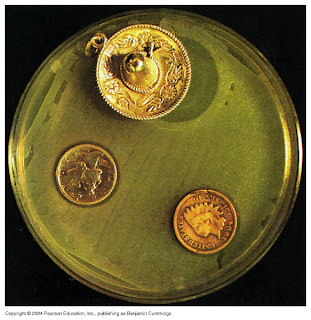CONTROL OF MOS BY CHEMICAL AGENTS CONTD..
D) HEAVY METALS & THEIR COMPOUNDS:
Heavy metals have larger atomic weight & complex electronic configuration. The detrimental effect of small amount of heavy metals on microorganisms is called "Oligodynamic Effect". This action can be seen when we place a coin or other clean piece of metal containing silver or copper on a culture media on an inoculated Petri Plate. The most effective metals are Hg,Ag, & Cu.
Fig: Oligodynamic Effect
Fig: Oligodynamic Effect
- Mercury(Hg): It is in the form of mercuric chloride is very toxic & its efficacy decreases in the presence of organic compound. So, other components of mercury are used like Mercurochrome, Metaphein etc.
- Copper(Cu): It is active against chlorophyll containing organisms & it is potent inhibitor of algae. Copper sulphate is incorporated to algicide & used in swimming pool & water supply.
- Silver(Ag): Silver is used in the form of silver nitrate as antiseptics & disinfectants. 1% silver nitrate is used in the eyes of new born to prevent Ophthalmia Neonatorum, which a gonococcal infection of eyes.
Used in ointments as antiseptics, used as fungicide & algicidal , used for the treatment of Ophthalmia Neonatorum, used in swimming pool & water supplies.
MODE OF ACTION:
- Heavy metals acts on cellular protein(Enzyme) & inactivate them.
- Mercuric chloride acts on the enzyme that contains sulfhydryl group.
- High concentration of heavy metals salts coagulates cytoplasmic protein.


Comments